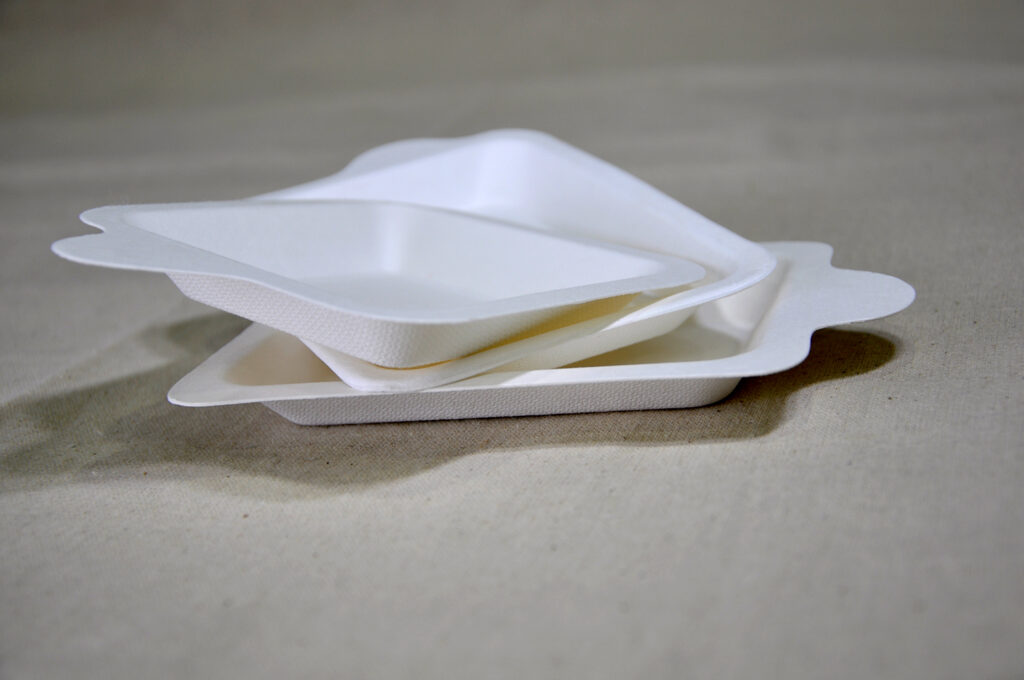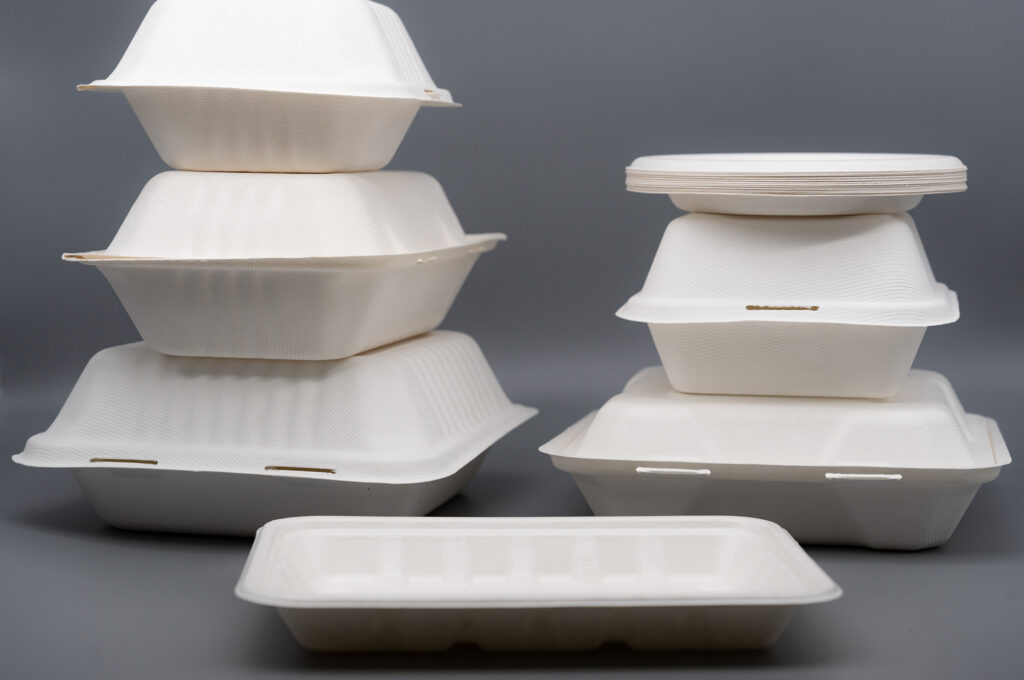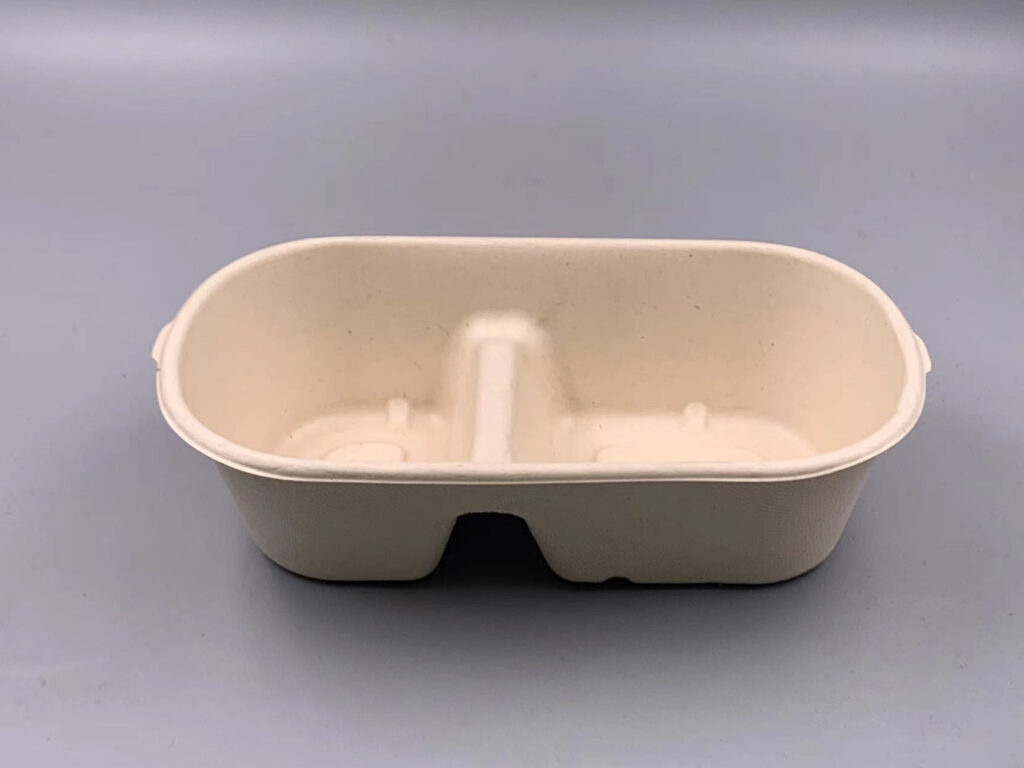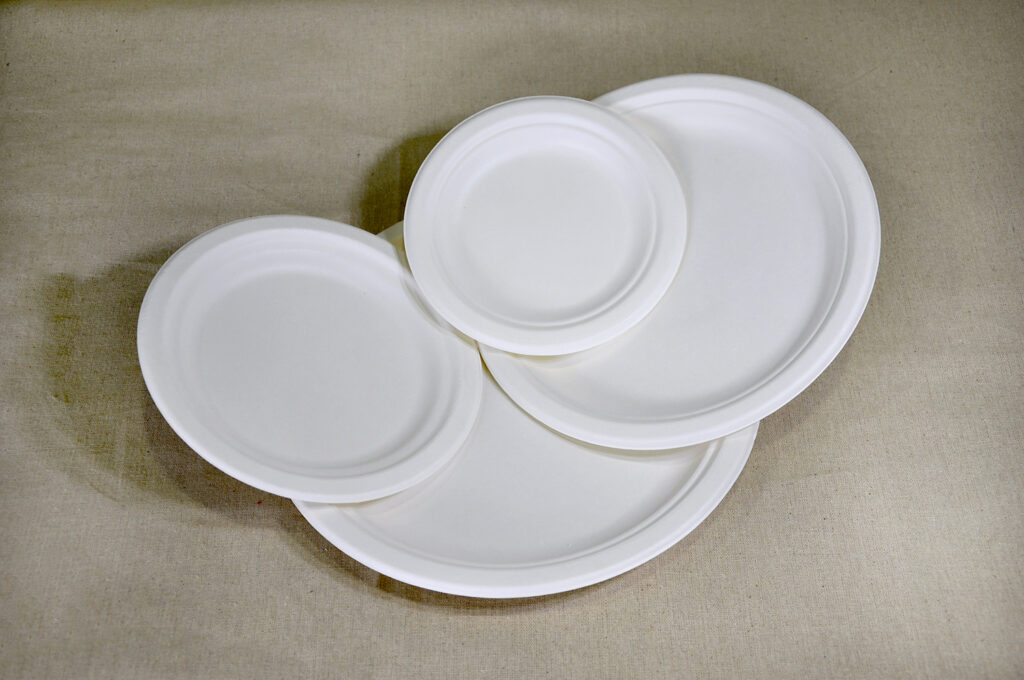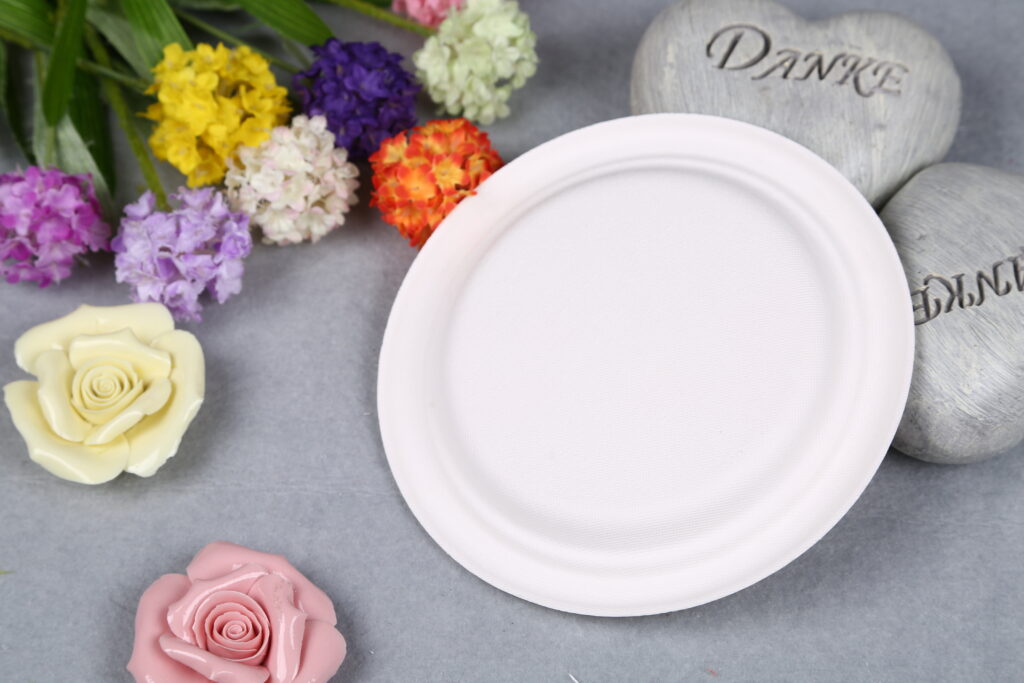Are Compostable Plates Really Eco-Friendly? A Deep Dive into Materials, Benefits, and Proper Disposal
1. Introduction
The conversation about reducing single-use plastic waste has been gaining momentum globally, and compostable plates are now at the forefront of this movement. From weddings to takeout services, these plates promise convenience while being kinder to the planet. But are they truly the eco-friendly solution they claim to be?
In this guide, we’ll unpack what compostable plates are, how they differ from biodegradable plates, the materials they’re made from, their environmental impact, and how to ensure you’re buying authentic eco eco-friendly plates—all while keeping disposal best practices in mind.
2. What Are Compostable Plates?
Compostable plates are single-use tableware designed to break down into non-toxic, nutrient-rich compost under the right conditions. Unlike traditional plastic or foam plates, which can take centuries to degrade, compostable options can disintegrate within weeks or months in industrial composting facilities.
To qualify as compostable, these plates must meet recognized standards such as ASTM D6400 or EN 13432, which require them to:
-
Break down within a set timeframe (usually 90–180 days) in composting conditions.
-
Leave no harmful residues or toxins.
-
Produce compost that supports healthy plant growth.
3. Biodegradable vs Compostable: What’s the Difference?
Although often used interchangeably, the terms mean different things, especially in practical and legal contexts:
| Feature | Biodegradable Plates | Compostable Plates |
| Breakdown Process | Naturally breaks down via microorganisms | Breaks down under specific composting conditions |
| Timeframe | Unspecified—could take years | Defined (90–180 days in facility) |
| Residue | May leave harmful residues | Leaves no toxic residue |
| Regulation | Not strictly regulated | Must meet strict standards (ASTM, EN) |
Key Message: All compostable plates are biodegradable, but not all biodegradable plates are compostable. For reliable eco-conscious end-of-life disposal, always prefer certified compostable products.
For a more detailed, comparative breakdown, check out our dedicated post on the difference between compostable and biodegradable plates. And if you’re curious about heating or microwaving these plates, see our guide on microwave safety for compostable plates.
4. Main Materials Used in Compostable Plates
4.1 Compostable Paper Plates
-
Source: Recycled paper pulp without plastic coatings.
-
Strengths: Lightweight, cost-effective, good for dry or low-oil foods.
-
Limitations: Lower durability with hot liquids or oily foods unless coated with plant-based barrier layers.
4.2 Bamboo Compostable Plates
-
Source: Fast-growing, renewable bamboo stalks or sheaths.
-
Strengths: Durable, naturally antibacterial, elegant appearance, suitable for premium dining and events.
-
Limitations: Slightly higher cost, may require more energy to mold into shape.
4.3 Bagasse (Sugarcane) Plates
-
Source: Fibrous byproduct of sugarcane processing.
-
Strengths: Strong, heat-resistant, excellent for industrial composting, and repurposes agricultural waste.
-
Limitations: Typically requires industrial composting to fully break down.
4.4 Areca Leaf Plates
-
Source: Naturally fallen Areca palm leaves.
-
Strengths: No chemicals used, rustic aesthetic, sturdy for both hot and cold foods.
-
Limitations: Regional availability may increase carbon footprint from transport.
4.5 PLA & Cornstarch-Based Plates
-
Source: Plant-based bioplastics like PLA (polylactic acid) from corn starch.
-
Strengths: Resembles traditional plastic, heat- and oil-resistant, food-safe.
-
Limitations: Needs high-temperature industrial composting; not suitable for home compost bins.
4.6 Mixed Plant Fiber Plates
-
Source: Blends of bamboo, wood pulp, and other natural fibers.
-
Strengths: Balanced cost and performance, versatile applications.
-
Limitations: Coatings may affect compostability if not plant-based.
4.7 Pure Cornstarch Plates
-
Source: 100% cornstarch polymers without PLA blending.
-
Strengths: Fully renewable, naturally biodegradable.
-
Limitations: Less heat resistance; requires industrial composting for rapid breakdown.
5. Production Process of Compostable Plates
-
Raw Material Collection & Cleaning – Sourcing agricultural byproducts or renewable plant matter; removing debris and contaminants.
-
Molding Process – Hot pressing or mold forming to shape plates, using high pressure and heat for durability.
-
Surface Treatment & Food-Grade Coating – Applying plant-based coatings for oil or moisture resistance.
-
Heating & Cooling – Controlled heating to cure materials, followed by cooling to stabilize the structure.
-
Automation & Manual Operations – Large-scale facilities use automated presses; artisan products (like Areca leaf plates) involve more manual work.
6. Environmental Impact & Sustainability
-
Compostable plates are often promoted as eco-friendly plates for good reason — their environmental footprint is typically far lighter than that of traditional plastic or foam disposables. But to truly understand their value, it’s important to look at measurable impacts, data-backed claims, and the broader sustainability context.
6.1 How They Reduce Carbon Footprint
One of the main advantages of compostable plates is the use of renewable, plant-based, or waste-derived raw materials such as bagasse, bamboo, or agricultural by-products. These resources regenerate naturally and lower our dependence on fossil fuels, which are heavily used in manufacturing conventional plastics.
Life Cycle Assessments (LCA) conducted by independent laboratories frequently show that compostable plates generate significantly lower greenhouse gas emissions throughout their lifespan — from raw material harvesting to disposal — compared to single-use plastic or foam alternatives.
For example:
-
Bagasse compostable plates can utilise waste sugarcane fibre that would otherwise be burned, preventing associated CO₂ emissions.
-
Bamboo compostable plates grow rapidly without pesticides, absorbing more CO₂ during cultivation than most hardwoods.
The combined effect is a measurable reduction in carbon footprint over the product’s life cycle.
6.2 Waste Management Advantages
Compostable plates align strongly with circular economy principles by turning what was once waste into nutrient-rich compost that supports soil health. When disposed of correctly through home or industrial composting, they:
-
Return valuable organic matter to the earth instead of becoming long-term waste.
-
Reduce landfill volumes, helping municipalities cut waste management costs.
-
Minimise plastic pollution in rivers and oceans, as they don’t persist for centuries like petroleum-based plastics.
By diverting organic waste away from landfills, compostable plates also reduce methane emissions — a greenhouse gas over 25 times more potent than CO₂ — generated from decomposing food and organic matter under anaerobic landfill conditions.
6.3 Research & Data Support
The environmental benefits are supported by credible, third-party research:
-
United Nations Environment Programme (UNEP) 2022 Report: Transitioning from conventional plastics to compostable materials in appropriate applications could reduce global plastic pollution by up to 70% by 2040.
-
US Environmental Protection Agency (EPA) Data: Compostable food service packaging helps divert significant volumes of organic waste from landfill streams, directly lowering methane emissions and contributing to municipal climate action goals.
Combined, these findings underline that when sourced responsibly, used in the right contexts, and disposed of properly, eco-friendly disposable plates can be a powerful tool in reducing environmental impact.
-
7. How to Recognize Authentic Eco-Friendly Compostable Plates
7.1 Look for Recognised Certifications
-
BPI Certified (USA)
-
OK Compost (TÜV Austria)
-
EN 13432 (EU Standard)
-
ASTM D6400 (USA Standard)
7.2 Greenwashing Warning Signs
-
Claims like “100% natural” without certification.
-
Shiny or plastic-like coatings without disclosure.
7.3 Transparency in Material Labelling
-
Clear listing of raw materials and compostability conditions.
7.4 Check for Composting Instructions
-
Should state whether home compostable or only suitable for industrial composting.
7.5 Durability and Performance Tests
-
Reputable brands publish test results for heat resistance, oil resistance, and load-bearing capacity.
8. How to Properly Dispose of Compostable Plates
8.1 Home Composting
-
Suitable: Areca leaf, uncoated paper, bamboo plates.
-
Breakdown: Weeks to months depending on moisture, temperature, and aeration.
8.2 Industrial Composting
-
Required: PLA, cornstarch bioplastic, coated fiber plates.
-
Facilities use high heat (55–70°C) to accelerate breakdown within 90–180 days.
8.3 What Not to Do
-
Do not burn—it can release CO₂ and pollutants.
-
Do not mix with plastic waste—causes contamination in recycling streams.
9. Performance & Usage Scenarios
9.1 Heat & Oil Resistance
-
Best: Bagasse, PLA-based, bamboo plates.
-
Moderate: Areca leaf, coated paper plates.
9.2 Event & Catering Applications
-
Weddings, festivals, corporate events, and takeout services benefit from reduced cleanup and eco-friendly branding.
9.3 Cost & Availability Comparison
-
Compostable plates are generally 10–30% more expensive than plastic or foam, but may qualify for sustainability grants or tax incentives.
9.4 Food Safety Considerations
-
Ensure compliance with FDA or EU food contact safety standards.
9.5 Environmental Impact During Use
-
Replacing single-use plastics reduces plastic litter and microplastics in the environment.
10. Conclusion – Compostable Plates Are More Than a Trend
Compostable plates combine environmental benefits with practical usability. By choosing authentic, certified products such as compostable paper plates and bamboo compostable plates, you support waste reduction, promote renewable resources, and enjoy reliable performance for various occasions.
The key is informed purchasing—knowing the material, understanding disposal methods, and avoiding misleading green claims. When used and disposed of correctly, compostable plates aren’t just a trend; they’re a sustainable choice for a cleaner future.
FAQs
Q1: Are Plastic & Foam Disposables Safe?
No. Single-use plastic and foam disposables can leach harmful chemicals—especially when exposed to heat—into food and beverages. They also persist for centuries in landfills and contribute heavily to marine pollution. For an in-depth look at the health and environmental risks, read our full guide on whether biodegradable plastic tableware is safe..
Q2: How to Avoid Buying Fake Eco-Friendly Plates?
Check for recognized compostability certifications and detailed material labeling.
Q3: Can Compostable Plates Be Microwaved?
Many compostable plates can be microwaved, but heat resistance varies greatly depending on the material. For example, compostable paper plates without a plastic lining and certain bamboo compostable plates can handle short bursts of heating, while PLA or cornstarch-based options may soften or warp under high heat.
Always check the manufacturer’s label for temperature limits and time recommendations to avoid damaging the plate or affecting food safety. For a detailed breakdown of which eco friendly disposable plates are microwave-safe and which aren’t, see our full guide on microwave safety for compostable and biodegradable plates.
Q4: How Long Do Compostable Plates Take to Break Down?
In industrial composting: 90–180 days. Home composting: a few months to over a year depending on conditions.
Q5: Are Bamboo Compostable Plates Better Than Paper Plates?
Bamboo plates are generally more durable and heat-resistant, while paper plates are lighter and often more affordable.






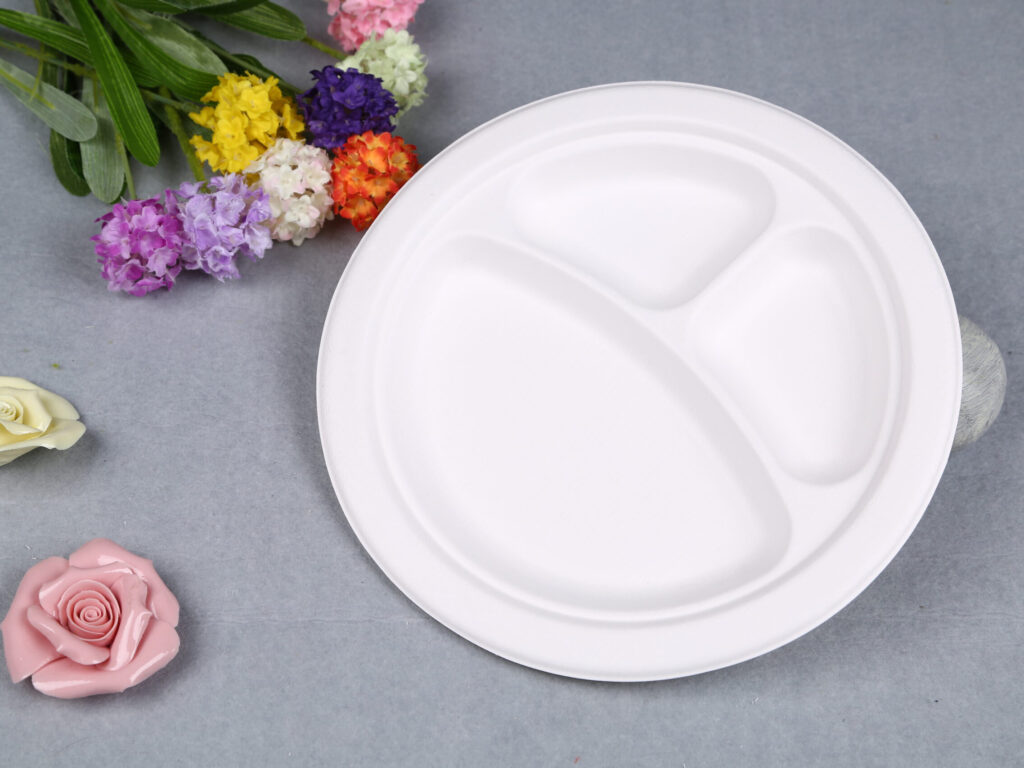
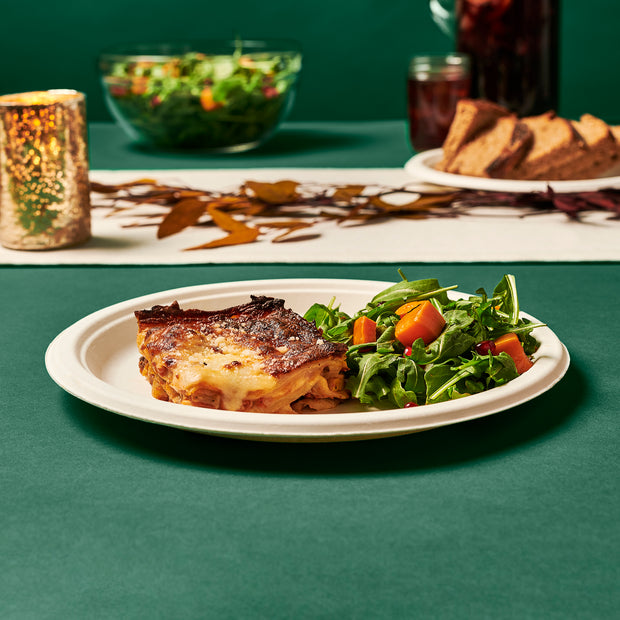 Now, let's talk about compostable. This term is much more specific and holds a higher standard for environmental responsibility. For a product to be labeled "compostable," it must meet strict requirements for breaking down into organic matter, water, and carbon dioxide within a specific timeframe, under specific conditions.
Think of it this way: compostable plates and cutlery are designed to decompose fully and safely into nutrient-rich compost, which can then be used to enrich soil. This process typically requires an industrial composting facility, where conditions like temperature, moisture, and aeration are carefully controlled to accelerate decomposition.
Here are the key characteristics of compostable products:
Now, let's talk about compostable. This term is much more specific and holds a higher standard for environmental responsibility. For a product to be labeled "compostable," it must meet strict requirements for breaking down into organic matter, water, and carbon dioxide within a specific timeframe, under specific conditions.
Think of it this way: compostable plates and cutlery are designed to decompose fully and safely into nutrient-rich compost, which can then be used to enrich soil. This process typically requires an industrial composting facility, where conditions like temperature, moisture, and aeration are carefully controlled to accelerate decomposition.
Here are the key characteristics of compostable products:
